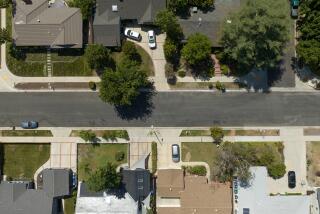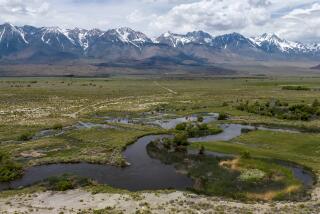Soaking up lessons of last drought
Watering the lawn under the moonlight. The specter of “water police.”
If the current water shortage is beginning to sound a lot like the great drought of 1990-91, grab a glass of water and chill.
Although Long Beach is beginning mandatory water restrictions and other communities are expected to join suit, the Southland’s water supply is in significantly better shape than it was 17 years ago.
Officials say they learned from that drought and spent the ensuing years building up water reserve capacity. Despite the record dry conditions, the Metropolitan Water District has 14 times more reservoir and groundwater storage than it did in 1991, with many local reservoirs flush with water. This is giving the region a buffer against a reduction in supplies from Northern California and the Colorado River.
Moreover, the region has learned to conserve in dramatic fashion.
In 1991, the average household used 210 gallons of water a day. Today, thanks to low-flow toilets, new shower heads and changes in behavior, that number has declined to about 180 gallons, according to water officials.
In a sign that the conservation message is sinking in, the Metropolitan Water District said it delivers the same amount of water -- 2.1 million acre feet a year -- to Southern California now as it did in 1990. That’s despite having 3 million more customers.
Water officials warn that more restrictions -- and possibly higher rates -- are on the way in the coming months. But they said this was not yet a crisis.
In fact, water officials and weather experts believe that further restrictions might result in enough savings to deal with the continued dryness and a recent court ruling that could yield a 30% reduction in water deliveries from Northern California.
Moreover, they argue that mandatory water reduction is important because Southern Californians need to learn how to do more with less as the region’s population grows and water supplies remain finite.
“Never have so many people had water so cheap, so clean and so uninterrupted as Southern California has for the last 50 years,” said Bill Patzert, a climatologist for the Jet Propulsion Laboratory in La Cañada Flintridge. “We just need to use water more rationally.”
The drought of 1990-91 bore some similarities to today. There were record dry conditions that affected not just Southern California but the two areas where the region gets much of its imported water: the Colorado River and Sacramento-San Joaquin Delta.
In response, the state cut water deliveries to the region -- only the second time in history that had happened.
Southern California was jolted. Restrictions on water use were imposed, prompting complaints from both residents and farmers. At the height of the drought, water deliveries to Southern California were reduced by half. Lawns shriveled and turned brown.
But there are also major differences between 1990-91 and today. Back then, water levels at state reservoirs were so low they were considered to be “essentially empty” -- creating a severe shortage of water for customers.
Today, the water supply is much more plentiful thanks to lessons learned from the drought.
“It taught us a lot,” said Debra Man, chief operating officer and assistant general manager for the Metropolitan Water District, which delivers water to most of Southern California. “We learned that we had to really diversify our water resources. We had to be prepared for some of the worst-case drought events.”
More than $3 billion has been spent on increased water storage above and below ground. In 1999, water importers built the 260-million-gallon Diamond Valley Lake in Riverside County. Also, before 1990, the MWD did not focus on groundwater storage. That changed because of the drought, and now aquifers are carefully managed.
The MWD had only 225,000 acre-feet stored in 1990. Today, the district has 2.7 million acre-feet in storage. An acre-foot is about 326,000 gallons, enough to cover an acre 1 foot deep or supply two households for a year.
Also over the last decade, officials moved to diversify the water supply. The district signed an agreement with an agency in the San Joaquin Valley to hold 350,000 acre-feet of MWD water from the State Water Project, which delivers water from Northern California to much of the Southland. The district has since signed agreements with other farming areas and desert water districts outside of Southern California to store an additional 700,000 acre-feet.
Man said a goal of the MWD is to reduce its reliance on water from the Colorado River and the State Water Project from 50% of the district’s supplies to 26% by 2025.
Despite these improvements, regional water officials said they expect more mandatory water rationing because of the current drought and water problems. Long Beach took the first step Thursday, imposing rules on when residents can water lawns and how restaurants serve water to customers.
Southern California is seeing its driest year on record. In addition, the region could see as much as 30% of its water supply cut because of a federal judge’s ruling last month.
U.S. District Judge Oliver W. Wanger ordered protective measures for a tiny endangered fish in the Sacramento-San Joaquin Delta. Delta smelt grow to about 3 inches and live about a year. A so-called indicator species that is a harbinger of ecological conditions in the delta, the smelt were declared threatened in 1993.
Long Beach officials said Friday that the city expects a water shortage and that it needs its residents to conserve more. Also, they said they hoped to permanently change how residents use water.
“This is a proactive step, and we’re hoping other cities follow,” said Kevin Wattier, general manager of the Long Beach Water Department. “Let’s be prudent and tighten our belt as much as we can.”
Over the years, more people have relied on devices such as low-flow toilets and shower heads, and municipal codes have been enacted to require new buildings to carry these devices. More water is recycled, and there has been a push for people to landscape with plants that do not require as much water.
But a lot more has to be done, experts say. Over the next half-century, according to a recent state projection, California’s population will grow by nearly 75% to about 60 million people. And the water supply is not going to keep up, officials said.
The MWD is having to dip into its reserves because of the drought conditions, a concern because those are designed to be saved for an emergency, such as a major earthquake.
And though the region has depended on water from the north, there have been signs over the years that that reliance needs to be eased.
In 2003, the MWD lost its exclusive rights to surplus water from the Colorado River because Arizona and Nevada began to get their full share. MWD lost half of its water from the river when that happened.
“We’re living in a desert,” said Patzert. “We should be using less water.”
--
More to Read
Sign up for Essential California
The most important California stories and recommendations in your inbox every morning.
You may occasionally receive promotional content from the Los Angeles Times.











